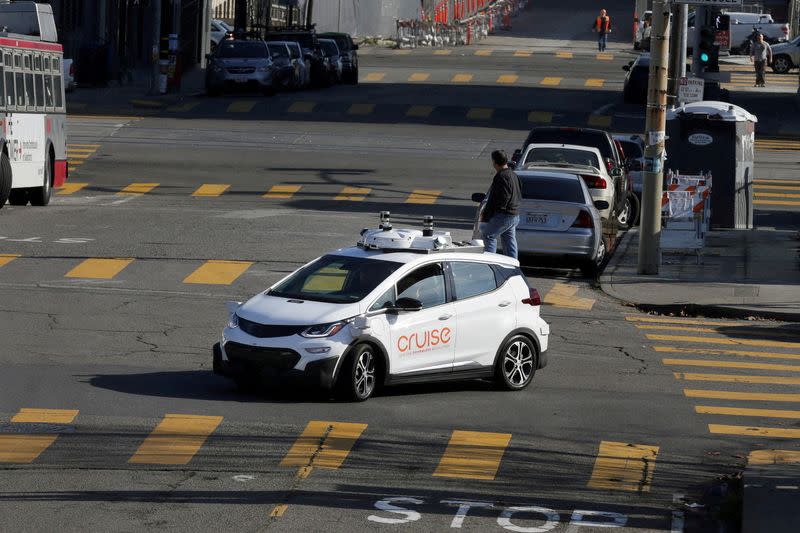Analysis-GM's Cruise faces long road back to city streets in wake of safety review

By Greg Bensinger
SAN FRANCISCO (Reuters) - General Motors' Cruise self-driving car unit faces a trip that could last the better part of this year to convince regulators and a wary public that its robotaxis are fit to share the road with human drivers, industry officials said.
After releasing a withering safety report last week that Cruise commissioned, GM said on Tuesday it slashed about $1 billion from Cruise's annual budget and promised to "soon" release a timeline for the unit's return to operations. The U.S. automaker also delayed indefinitely a March update when it was expected to lay out plans.
That has raised questions about when Cruise might get its vehicles back on the road, particularly as it faces various government probes including from the National Highway Traffic Safety Administration.
"Investigating defects is a highly deliberative process," said Mark Rosekind, a former NHTSA chief who has also worked for Amazon.com's Zoox autonomous vehicle unit. "It would be months, easily, and for bigger problems up to a year or more to resolve an investigation."
Despite the struggles, GM CEO Mary Barra reiterated her commitment on Tuesday to a business that recorded a $2.7 billion pretax loss last year and burned $1.9 billion in cash.
The autonomous car developer trimmed a quarter of its staff and grounded its entire U.S. fleet after an October accident in which a woman was dragged 20 feet (6.1 meters) by a Cruise vehicle in San Francisco after being struck by a human driver.
Cruise, by both missteps and design, withheld evidence from regulators, the press and the public in the accident's wake, according to the report by law firm Quinn Emanuel. Following the accident, California officials pulled Cruise's permit to operate in the state and NHTSA issued a recall of Cruise vehicles.
Before Cruise can again send its distinctive orange and white Chevrolet Bolts onto city streets, it must run a gauntlet of regulators, including California's Public Utilities Commission and Department of Motor Vehicles. Cruise last week revealed probes by the U.S. Justice Department and Securities and Exchange Commission but declined to provide additional details.
NHTSA declined to comment beyond confirming it has two Cruise investigations underway.
Rosekind said Cruise should be proactive in disclosing more data, more frequently, to regulators as it seeks to revive open-road testing.
"We have not set a timeline for deployment," Cruise spokesman Erik Moser said. "Our goal is to relaunch in one city with supervised driving as soon as possible once we have taken steps to rebuild trust with regulators and the public."
However, according to three people familiar with the matter, Cruise executives told some engineering and operations staff in internal meetings in recent weeks that they should not expect to see its robotaxis on city streets again until the fourth quarter. The sources declined to be identified because they were not authorized to speak on Cruise's behalf.
"The idea that we don't plan to have supervised driving operations before the fourth quarter is misinformed," Moser said. He did not provide a timeline for when Cruise's fully driverless trips will return.
Cruise lost its California permit in October and later faced a NHTSA recall, prompting it to ground its entire U.S. fleet.
While Cruise has not revealed where it will seek to relaunch its service, people familiar with the matter said it is considering Houston and Dallas as likely cities. The Texas Department of Public Safety, which regulates autonomous vehicles in the state, did not respond to a request for comment.
Such a relaunch would likely begin with as few as 10 cars in each city and no passengers, one of the sources said. By comparison, Cruise last year had about 300 fully autonomous cars in San Francisco with plans to add operations in at least 10 cities.
"It will take Cruise time, meaningful time, to earn back the trust of regulators," said Matthew Wansley, a Cardozo School of Law professor who specializes in emerging automotive technologies. "Regulators and the public rely on the good faith of these companies and it appears Cruise misled them both by omission of the facts."
A technological analysis by engineering firm Exponent, commissioned by Cruise, found that in the October accident the Cruise vehicle failed in several ways. These include inaccurately sensing the woman's location, detection of what part of the car hit her and the car's placement, so that it kept moving instead of making an emergency stop after striking the woman.
However, GM's Barra asserted on Tuesday that "we had already demonstrated and validated externally that Cruise technology is already safer than a human driver."
Barra said GM is working to ensure it can retain Cruise staff critical to developing the technology.
Cruise has been cutting costs in other ways, including by doing away with free food at company offices, a perk common in Silicon Valley.
Starting earlier this month, a memo reviewed by Reuters showed, Cruise began charging workers $10 for hot meals and $2.50 for barista-served hot coffee.
(Reporting by Greg Bensinger; Additional reporting by Hyunjoo Jin in San Francisco; Editing by Ben Klayman and Richard Chang)


